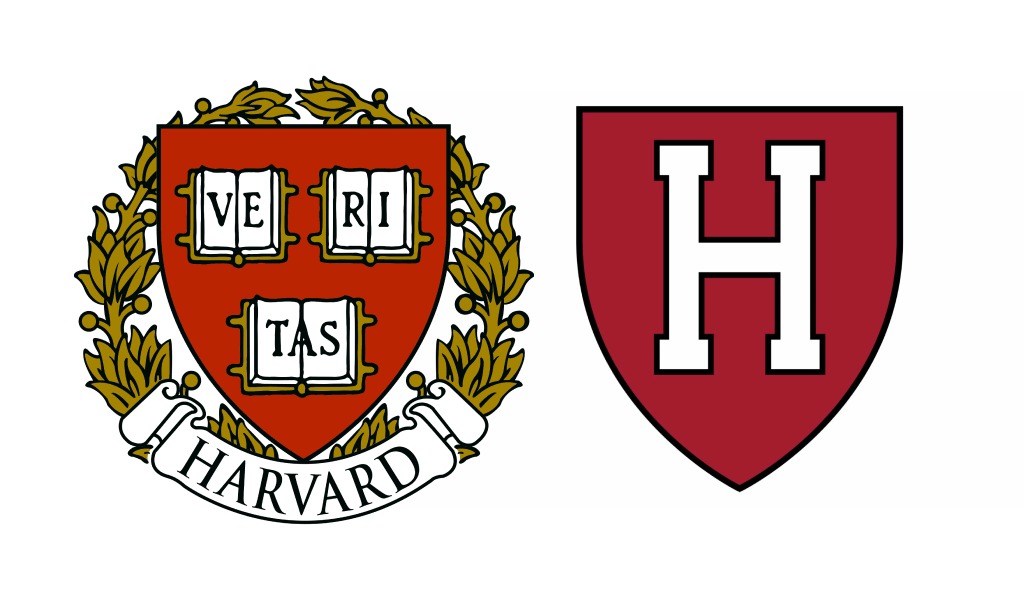It is difficult to find an educated person nowadays who has never heard of Harvard University. Located in Cambridge, Massachusetts, it is one of the most authoritative and elite universities in the world. Founded in 1636, it is the oldest institution of higher education in America. Moreover, it is a member of the Ivy League group. John Adams and John Hancock, signers of the Declaration of Independence, were alumni of Harvard. A significant factor in its great popularity is its logo – a simple but significant coat of arms with a rich history and deep symbolic meaning worth learning.
Table of Contents
Introduction to Harvard’s Iconic Emblem
The emblem bears the name of the first philanthropist, the patron, and priest, John Harvard. A sketch of the logo in subtle colors was found accidentally in the college archives by a student who would become a university president, Josiah Quincy, in the future. It was first officially introduced to the public on a white banner that was hung in a large tent during the bicentennial celebration on September 8, 1836. Later, in 1843, it was officially adopted by the Harvard Corporation as its coat of arms, and the one used today is very similar.
What Does the Harvard Logo Look Like?
The Harvard University logo features a crimson shield with three open books, each inscribed with the Latin word “Veritas” (truth). The emblem symbolizes knowledge, truth, and the university’s commitment to learning.
Breakdown of Harvard Logo Elements
- Shield: A traditional heraldic element representing history and prestige.
- Books: Three open books bearing the word “Veritas”, symbolizing the pursuit of truth.
- Crimson Color: Harvard’s official color, representing energy and tradition.
- Laurel Wreath (optional): Sometimes used in ceremonial versions, signifying achievement.
Origins and Evolution: Charting the Harvard Logo’s Legacy

The emblem has a long history. Although the author and the exact date of its creation are still unknown, some traces can be found. They are connected with Harvard’s motto the university had in 1692, a Latin phrase “Veritas Christo et Ecclesiae” which means “Truth for Christ and the Church”. It can still be found on the walls of many academic buildings: the Widener library, Memorial Church, and dormitories in Harvard Yard.
An interesting fact that shows the ability of students to influence the university’s life was connected with the color of the emblem. It received the crimson color only in 1910, under universal student suffrage. More than 1800 people voted for it. The color, which now distinguishes the university from all others and serves as the basis for the logo, was first used during a traditional regatta in 1858, where athletes wore crimson scarves to represent the university.
Symbolism Behind the Harvard Shield: Colors and Motto
Not only are the logo elements symbolic, but other design elements like the color and the motto of the Harvard arms are also meaningful.The Latin motto “Veritas” is inscribed fragmentarily on three books as VE, RI, and TAS. The books in the upper row have the first two syllables, while the third book is in the narrow part of the shield with the last part of the word. “Veritas” embodies Harvard’s commitment to truth-seeking, critical thinking, and intellectual integrity. It has become a guiding principle for anyone in their quest for knowledge and discovery. This design symbolizes a core ethos of Harvard’s academic mission: the pursuit of knowledge, truth, and enlightenment.
The crimson shade of Harvard emblem stands for passion, courage, and leadership. It reflects the spirit, academic excellence, and pioneering contributions to academia and society.
Controversies and Changes: Debates Over Design
The design choices of the Harvard College logo have been the subject of debates and controversies over the years. One debate at Harvard revolves around maintaining traditional design elements versus embracing modern aesthetics. Critics argue that the university’s iconic logo, rooted in historical symbolism, may appear outdated nowadays. Proponents advocate for preserving tradition while incorporating contemporary design trends to appeal to a diverse audience.
Modern Interpretations: The Arts and Sciences Harvard Logo Today
The image has set a benchmark for timeless design, combining classic elements with contemporary appeal. Its balanced composition, Garamond typeface, and symbolic imagery inspire modern logos in corporate branding, and cultural institutions.
Color Psychology
The color palette associated with the Harvard logo signifies excellence, innovation, and authority in modern branding. Many organizations leverage similar shades of red to convey strength, passion, and sophistication in their visual identities.
Minimalism and Elegance
The Harvard logo demonstrates the power of minimalistic design in communicating complex ideas effectively.
Harvard’s Brand Identity: Impact on Global Recognition
The Harvard logo’s iconic elements—such as the open books and Veritas motto—have inspired other educational institutions to create logos that convey a sense of heritage, prestige, and academic rigor. The use of symbolic imagery and meaningful typography in modern logos reflects a dedication to authenticity and old customs.
Conclusion: The Enduring Legacy of Harvard’s Logo
The history of Harvard University and its logo is a long-lasting story of striving for truth and knowledge, reflected in a design, simple but significant. The Harvard University logo is not just an image; it stands as a moral compass, a testament to scholarly tradition, intellectual curiosity, and moral astuteness. It unites generations of students, graduates, and teachers in a single pursuit of knowledge and truth.
Frequently Asked Questions
What does the Harvard logo represent?
It represents truth (“Veritas”), knowledge, and academic excellence.
What are the books in the Harvard logo?
They are three open books with “Veritas” inscribed, symbolizing truth and learning.
Why is Harvard’s color crimson?
Crimson became Harvard’s official color in the 1800s and reflects the university’s identity.

SEO specialist, link builder, and blog editor at Turbologo. Writing insightful content about marketing, design, and branding. Sharing practical tips on building and promoting brands online.









